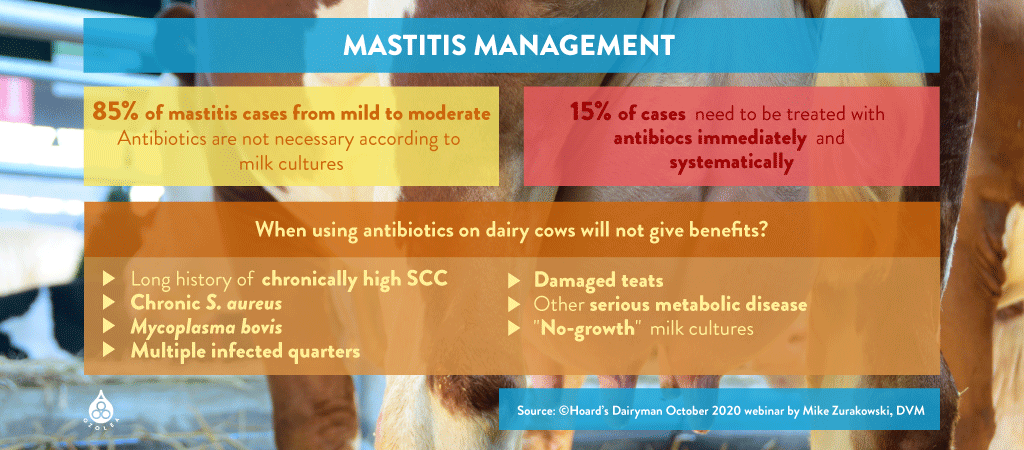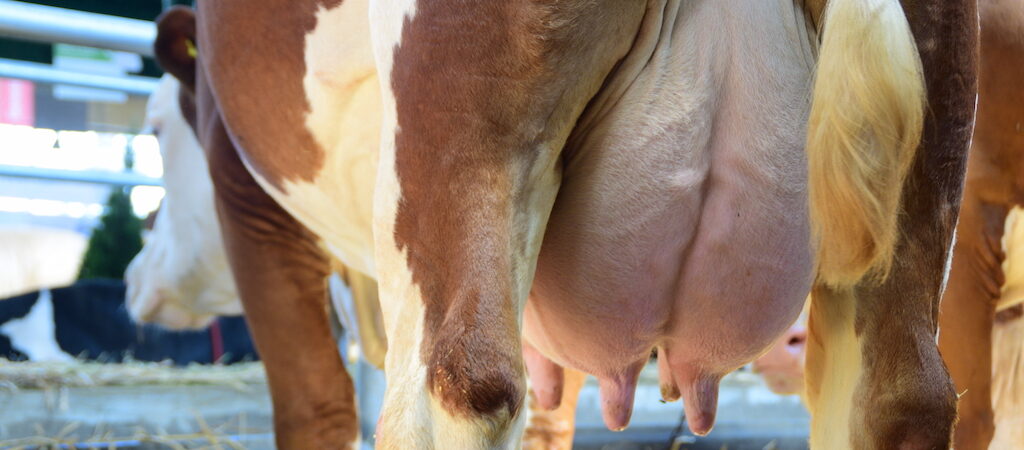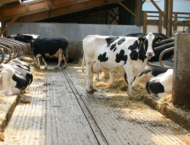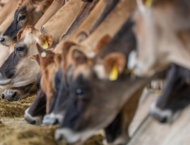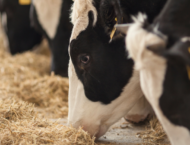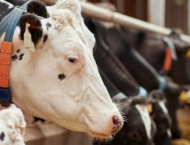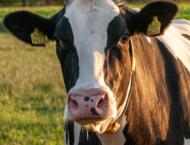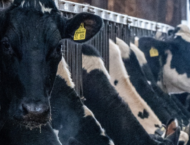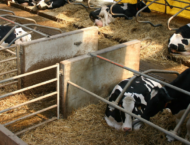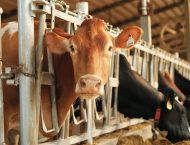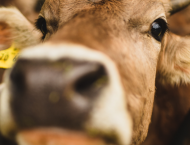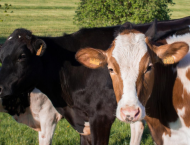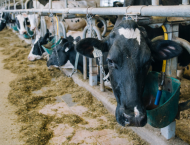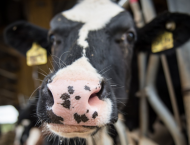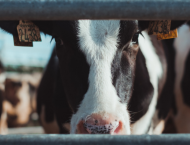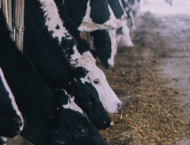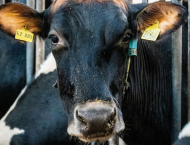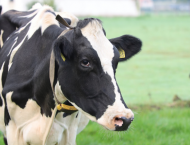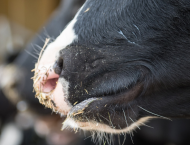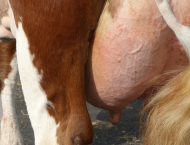Mastitis can occur in dairy cows at different severity levels. In the past weeks (read “What milk changes tell us when we forestrip”), we made an overview about the visible signs at milk level according to the severity of the clinical or subclinical mastitis. All these aspects will help us act promptly with the proper decisions and solutions.
Not all mastitis cases need an antibiotic treatment
From his field activity, Mike Zurakowski, DVM (Cornell Quality Milk Production Services) was able to verify that around 85% of mastitis cases are mild or moderate. These are cases that do not require a systemic and immediate treatment: thus, waiting 24-36 hours for the treatment will not change the results. In this range of time, we evaluate for an autonomous regression of the disorder.
The remaining 15% of cases should be treated immediately and systematically.
Defining and developing a mastitis management plan is critical for the prevention and/or control of mastitis. This means that we must work methodically and find out any critical point that deserves higher attention on our dairy farms.
Moreover, milk cultures are crucial to determine what type of pathogens have caused the infection at udder level. Culturing the milk helps us to discriminate between contagious or environmental pathogens. It also gives clues about whether an antibiotic treatment is needed or not and, thus, what antibiotic has to be applied, if needed.
This approach follows a pathogen-based treatment decision pattern for mastitis. It is extremely useful: it can contribute to the prudent use of antibiotics; it allows the farmer to save money on health care and labor expenses; it helps decrease antibiotic residues in the milk tank and minimize milk losses; it mitigates the risk of antimicrobial resistance since the treatment will be targeted and clearly established on the basis of analyses.
Some dairy cows will not benefit from antibiotic usage
When dealing with mastitis, there are some situations in which treating affected animals with antibiotics will not be beneficial.
Long history of chronically high SCC
Each dairy cow has her own personal lactation history. We published in Hoard’s Dayriman Guest Blog an article discussing this issue. High SCC values in milk can be related both to bacterial factors (intra-mammary infections) and other factors (environmental changes, stressful conditions, micro-traumas, etc.). When the milk culture tells us that there is no infection in the udder, the udder tissue may be stressed because of other reasons. As we saw in HD Guest Blog, supporting and protecting the udder tissue are a helping hand in reducing chronically high SCC values. This can be one of the several applications of OZOLEA-MAST in lactating cows.
Repeated previous treatment failures
Last week, when we discussed how biofilms are involved in recurrence of clinical mastitis, we also said that there is a link with increased resistance to antimicrobial substances leading also to repeated failures in treating the cow with antibiotics. The effectiveness of the specific antibiotic relies also on the synergies between the active substance and the udder tissue: when the latter is stressed and damaged, these synergies are reduced. Protecting the damaged udder tissue would be beneficial for the antibiotic activity, as well. Another potential application for OZOLEA-MAST.
Chronic Staphylococcus aureus
S. aureus is a hostile enemy for dairy farmers. Subclinical infections caused by this bacterium remain the largest mastitis issue in dairy cattle: despite in vitro effectiveness of active substances, in vivo cure rates with antibiotics are very low during lactations and the infection tends to become chronic. The reason behind low cure rates lies in the ability of S. aureus to form micro-abscesses that prevent active substances from reaching the microorganism. Unfortunately, chronicization of the infection makes culling the only frequent option. S. aureus causes contagious mastitis; therefore, it is generally spread from cow to cow via milking equipment, the milker’s hands, and improper hygiene and milking sequence. We can control it through prevention of new infections and the culling of affected animals.
In case of S. aureus that gives milk flakes and up-and-down SCC values, OZOLEA-MAST can help mitigate these signs for better herd management while taking time to sort the problem out through the vaccination of the herd or the replacement of animals.
Mycoplasma bovis
Mycoplasma bovis is a respiratory pathogen and can cause polyarthritis in beef cattle. Moreover, it is also recognized as a primary pathogen of mastitis in dairy cows. The infection it causes can become persistent, characterized by progressive chronicization. In this case, affected dairy cows will not benefit from therapy since there are no effective antibiotics or vaccines for the treatment or prevention of the mammary infections generated by this pathogen. Again, in case of M. bovis infections culling is the option recommended for controlling.
Multiple infected quarters
When more than one quarter is affected by mastitis, the dairy farmers should better consider a clinical picture of the situation as their priority. Thus, veterinary advice becomes essential in this situation. Also in this case, supporting the udder tissue and protecting it will help us to take time to find the proper solution.
Damaged teats
Teats can be damaged in many different ways. Dairy cows can smash teats themselves, or injury can occur during milking. Damaged teats are more susceptible to infections: in this case, what should be treated first is the specific physical injury.
Other serious metabolic disease
There is a connection between mastitis and metabolic diseases in dairy cows. Metabolic diseases generally depend on nutrient deficiency or excess. A balanced diet is essential for the proper functioning of all the physiological mechanisms and defensive system in the dairy cow. As we had the opportunity to discuss, there is particular attention to nutritional aspects around calving. A weakened defensive system means major susceptibility to infections also at udder level.
No-growth milk cultures
Negative results when culturing milk mean that, if sampling, transport of samples and analysis have been conducted properly, the dairy cow has autonomously solved the infection thanks to the immune system. Thus, even if there are signs of mastitis, using antibiotics would be not necessary. We can instead support the functionality of the udder tissue with proper protection.
